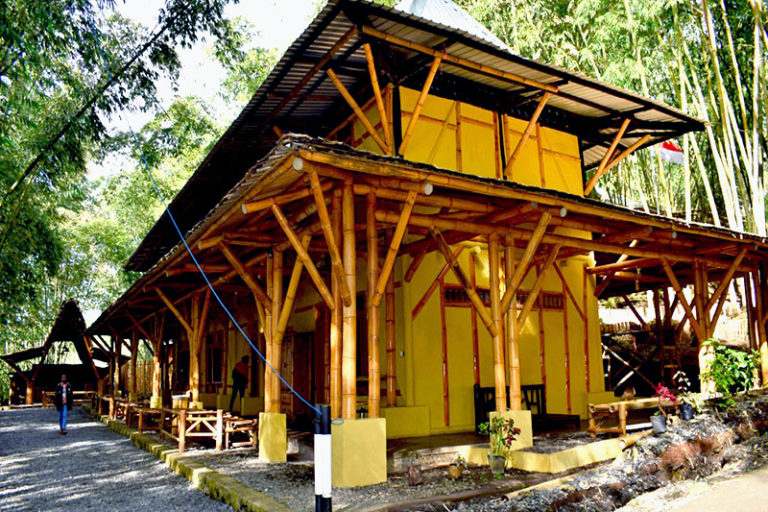- Architect Yu Sing is among a number of notable Indonesian architects prizing natural materials and traditional techniques as part of contemporary design.
- For more than a decade, Yu Sing’s Bandung-based Studio Akanoma has built projects great and small, from showpiece convention spaces to communal bamboo kitchens for women farmers.
- In 2009, Yu Sing published a book, Mimpi Rumah Murah, setting out his vision for affordable homes using locally available natural materials.
MADURA, Indonesia — For centuries, every architect in Indonesia relied on local materials when constructing homes and public spaces. Today Yu Sing is one of the few holding onto this heritage.
“Natural houses are no longer the first choice for people’s homes,” Yu Sing said. “The state even calls them uninhabitable homes.”
The Java-born architect sees it differently. Yu Sing is one of a number of notable Indonesian architects, such as Realrich Sjarief and Yori Antar, who prize traditional techniques and materials as part of modern practice.
After graduating from the architecture faculty of the Bandung Institute of Technology, Yu Sing founded Studio Akanoma in 2008 to showcase new design of low-cost housing using natural materials. A year later he published his first book, Mimpi Rumah Murah — “Dreams of Affordable Homes.” The book covered Yu Sing’s design process and a breakdown of development costs, which are often low when opting for local building materials.
Studio Akanoma cites the decline in the use of nipa, a mangrove palm, in roofing. It used to be a freely available material used in much of Sumatra’s Jambi province, but today most new homes opt for more expensive zinc sheets because the nipa palms are widely seen as backward.
Some believe the palm fronds will last only one year before a replacement thatch is required, but Yu Sing said this perception is misplaced.
Nipa, when thatched correctly, can ensure waterproofing, cooler temperatures and quieter living conditions compared with the disruptive patter of rain on a hot zinc roof. In Vietnam, for example, the leaves are still commonly used in the walls and ceilings of well-designed homes.
“This is a treasure, a source of material and knowledge that is so abundant in Indonesia,” he said.
Studio Akanoma tackles both large architectural commissions as well as smaller community projects. Just outside Bogor, a suburb of Jakarta, the Akanoma-designed Wika Satrian Leadership Center is a contemporary dome of contours and neat, open lines enabling natural indoor cooling.
Yu Sing also oversees modest projects in the community, such as a communal kitchen for a women’s group from the village of Panglungan in Jombang district, East Java province.
In 2016 Yu Sing and colleagues designed the simple kitchen from bamboo for a local women’s group. The kitchen was a place to learn and hone their craft, producing food from wild plants and locally grown produce.
The kitchen’s bamboo roof appears inverted, but it is a deliberate technique to retain rain for drinking water.

Bamboo has been used for food and shelter for centuries across these islands, but when Yu Sing hired carpenters to build the structure, he found bamboo was almost a novel commodity for the tradesmen.
“They said it was their first time as carpenters to have a lot of bamboo to make bamboo constructions,” he said.
The kitchen walls are made from a composite of soil, rice straw, rice husk, limestone and cow manure.
In Ciawi, West Java province, Yu Sing took bamboo from a local forest and designed a rainwater retention system to preclude the need to drill for groundwater.
The architect said he believes loss of reliance on nature for building materials is reinforcing our waning connection to nature more broadly — a trend Yu Sing is trying to confront in his contemporary architecture.
“Why is nature broken? Because we don’t depend on nature,” he said. “It’s as if we don’t need to preserve nature.”
Banner image: Women from a village in Bali in front of a house that preserves the traditional architecture with earthen wall. Image by Luh De Suriyani/Mongabay Indonesia.
This story was reported by Mongabay’s Indonesia team and first published here on our Indonesian site on June 14, 2023.
This story first appeared on Mongabay
South Africa Today – Environment
This article is licensed under a Creative Commons Attribution-NoDerivatives 4.0 International License.
You may republish this article, so long as you credit the authors and Mongabay, and do not change the text. Please include a link back to the original article.












